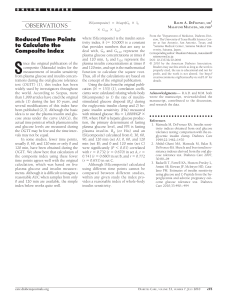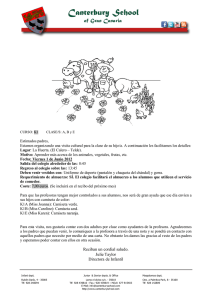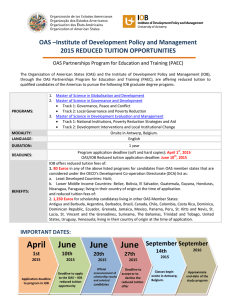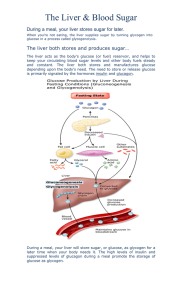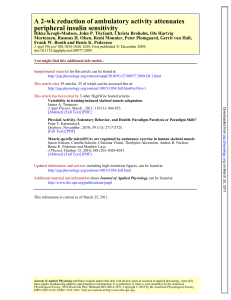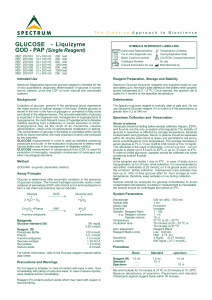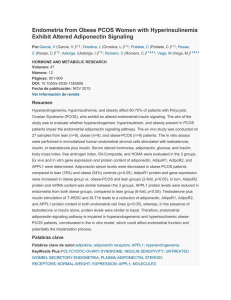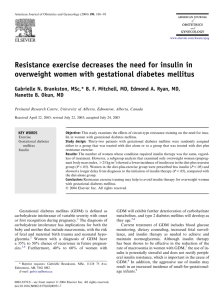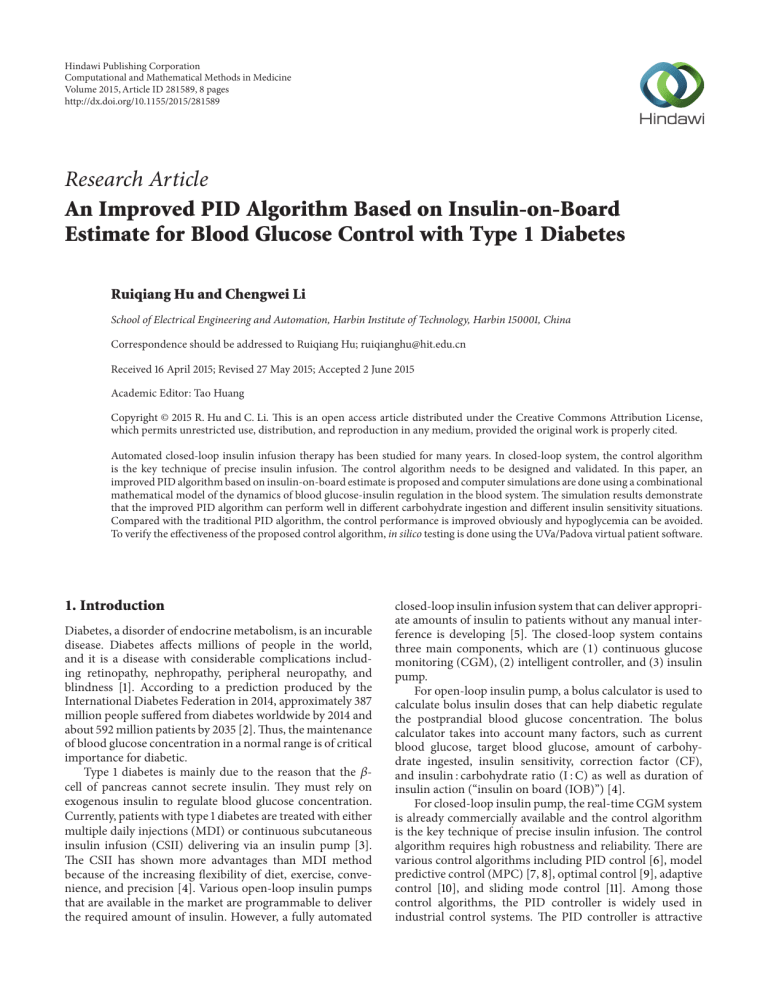
Hindawi Publishing Corporation
Computational and Mathematical Methods in Medicine
Volume 2015, Article ID 281589, 8 pages
http://dx.doi.org/10.1155/2015/281589
Research Article
An Improved PID Algorithm Based on Insulin-on-Board
Estimate for Blood Glucose Control with Type 1 Diabetes
Ruiqiang Hu and Chengwei Li
School of Electrical Engineering and Automation, Harbin Institute of Technology, Harbin 150001, China
Correspondence should be addressed to Ruiqiang Hu; ruiqianghu@hit.edu.cn
Received 16 April 2015; Revised 27 May 2015; Accepted 2 June 2015
Academic Editor: Tao Huang
Copyright © 2015 R. Hu and C. Li. This is an open access article distributed under the Creative Commons Attribution License,
which permits unrestricted use, distribution, and reproduction in any medium, provided the original work is properly cited.
Automated closed-loop insulin infusion therapy has been studied for many years. In closed-loop system, the control algorithm
is the key technique of precise insulin infusion. The control algorithm needs to be designed and validated. In this paper, an
improved PID algorithm based on insulin-on-board estimate is proposed and computer simulations are done using a combinational
mathematical model of the dynamics of blood glucose-insulin regulation in the blood system. The simulation results demonstrate
that the improved PID algorithm can perform well in different carbohydrate ingestion and different insulin sensitivity situations.
Compared with the traditional PID algorithm, the control performance is improved obviously and hypoglycemia can be avoided.
To verify the effectiveness of the proposed control algorithm, in silico testing is done using the UVa/Padova virtual patient software.
1. Introduction
Diabetes, a disorder of endocrine metabolism, is an incurable
disease. Diabetes affects millions of people in the world,
and it is a disease with considerable complications including retinopathy, nephropathy, peripheral neuropathy, and
blindness [1]. According to a prediction produced by the
International Diabetes Federation in 2014, approximately 387
million people suffered from diabetes worldwide by 2014 and
about 592 million patients by 2035 [2]. Thus, the maintenance
of blood glucose concentration in a normal range is of critical
importance for diabetic.
Type 1 diabetes is mainly due to the reason that the 𝛽cell of pancreas cannot secrete insulin. They must rely on
exogenous insulin to regulate blood glucose concentration.
Currently, patients with type 1 diabetes are treated with either
multiple daily injections (MDI) or continuous subcutaneous
insulin infusion (CSII) delivering via an insulin pump [3].
The CSII has shown more advantages than MDI method
because of the increasing flexibility of diet, exercise, convenience, and precision [4]. Various open-loop insulin pumps
that are available in the market are programmable to deliver
the required amount of insulin. However, a fully automated
closed-loop insulin infusion system that can deliver appropriate amounts of insulin to patients without any manual interference is developing [5]. The closed-loop system contains
three main components, which are (1) continuous glucose
monitoring (CGM), (2) intelligent controller, and (3) insulin
pump.
For open-loop insulin pump, a bolus calculator is used to
calculate bolus insulin doses that can help diabetic regulate
the postprandial blood glucose concentration. The bolus
calculator takes into account many factors, such as current
blood glucose, target blood glucose, amount of carbohydrate ingested, insulin sensitivity, correction factor (CF),
and insulin : carbohydrate ratio (I : C) as well as duration of
insulin action (“insulin on board (IOB)”) [4].
For closed-loop insulin pump, the real-time CGM system
is already commercially available and the control algorithm
is the key technique of precise insulin infusion. The control
algorithm requires high robustness and reliability. There are
various control algorithms including PID control [6], model
predictive control (MPC) [7, 8], optimal control [9], adaptive
control [10], and sliding mode control [11]. Among those
control algorithms, the PID controller is widely used in
industrial control systems. The PID controller is attractive
2
Computational and Mathematical Methods in Medicine
for blood glucose control based on the features of simple
structure with few parameters, easy implementation, good
adaptation, and robustness.
Many closed-loop control algorithms had not considered
the IOB factor. A limitation of IOB can optimize the output
of control algorithm and decrease the risk of hypoglycemia.
As the open-loop insulin pump, the previous insulin administration may lead to hypoglycemia. So the IOB estimate is
considered to limit the insulin infusion dose. In this paper,
the improved PID control algorithm based on IOB estimate
is introduced. Controller performance is evaluated in a
simulation study under a physiological model and considered
the carbohydrate ingestion and insulin sensitivity changed.
Also, the UVa/Padova virtual patient software is used to verify
the effectiveness of PID controller with IOB estimate.
The paper is organized as follows. In Section 2, a combinational complicated and detailed model of glucose-insulin
kinetic is introduced, which is based on the Hovorka et al. and
Dalla Man et al. model. The PID controller with IOB estimate
is designed, and the performance is evaluated by simulation
in Section 3. The in silico testing using ten virtual patients
is discussed in Section 4. The final conclusion is located in
Section 5.
̇ = 𝑥1 (𝑡) 𝑄1 (𝑡) − [𝑘12 + 𝑥2 (𝑡)] 𝑄2 (𝑡) ,
𝑄2 (𝑡)
2. Glucose-Insulin Mathematical Model
Mathematical models of glucose-insulin interactions have
been studied for over the past 50 years. Simple linear models
were proposed by Ackerman et al. [12]. More complicated
nonlinear models were proposed in later studies. In many of
these models, compartmental modeling approach has been
used. In this approach, the body is divided into compartments
representing different organs or parts of the body and
mass balance equations are derived for each compartment.
The compartmental minimal model of Bergman et al. [13]
has been widely used in many studies. More complicated
compartmental models proposed by Cobelli and Mari [14],
Hovorka et al. [15], and Dalla Man et al. [16] have considered
more compartments for better understanding the behavior
of different parts of the body. These models for glucoseinsulin interactions have been widely used in studying the
physiological behavior of diabetic patients.
In this paper, the glucose and insulin metabolic model
refers to the model developed by Hovorka et al. [15] and
Dalla Man et al. [16, 17]. The Hovorka model is a nonlinear
compartmental model with three subsystems for glucose,
insulin, and insulin action. The carbohydrate digestion and
absorption model refers to Dalla Man’s model in this paper.
The combinational model is close to a realistic patient model.
2.1. Glucose Subsystem. The glucose subsystem is divided
into two compartments: masses of glucose in the accessible
compartment and masses of glucose in the nonaccessible
compartment. The core model is a two-compartment representation of glucose kinetics. Consider
̇ = −[
𝑄1 (𝑡)
𝑐
𝐹01
𝑉𝐺𝐺 (𝑡)
𝐺 (𝑡) =
𝑄1 (𝑡)
,
𝑉𝐺
𝑐
𝑐
𝐹01
{
{𝐹01
= {𝐹 𝐺
{ 01
{ 4.5
if 𝐺 ≥ 81 mg/dL,
otherwise,
{0.003 (𝐺 − 9) 𝑉𝐺
𝐹𝑅 = {
0
{
otherwise,
(1)
where 𝑄1 and 𝑄2 are the masses of glucose in the accessible
and nonaccessible compartments, respectively. 𝑘12 is the
transfer rate constant from the nonaccessible to the accessible
compartment. 𝑉𝐺 is the distribution volume of the accessible
compartment. 𝐺 is the glucose concentration. EGP0 is the
endogenous glucose production extrapolated to the zero
𝑐
is the total insulin-independent
insulin concentration. 𝐹01
glucose flux, corrected for the ambient glucose concentration.
𝐹𝑅 is the renal glucose clearance above the glucose threshold
of 162 mg/dL. The gut absorption rate 𝑈𝐺 is introduced in
Section 2.4 of carbohydrate digestion and absorption model.
2.2. Insulin Subsystem. The insulin subsystem describes the
insulin absorption and insulin action on glucose kinetics. The
plasma insulin concentration 𝐼(𝑡) is described by
̇ = 𝑈 (𝑡) − 𝑘𝑒 𝐼 (𝑡) ,
𝐼 (𝑡)
𝑉𝐼
(2)
where 𝑘𝑒 is the fractional elimination rate and 𝑉𝐼 is the
distribution volume.
2.3. Insulin Action Subsystem. The three insulin actions on
glucose kinetics are represented by
𝑥1̇ = − 𝑘𝑎1 𝑥1 (𝑡) + 𝑘𝑏1 𝐼 (𝑡) ,
𝑥2̇ = − 𝑘𝑎2 𝑥2 (𝑡) + 𝑘𝑏2 𝐼 (𝑡) ,
(3)
𝑥3̇ = − 𝑘𝑎3 𝑥3 (𝑡) + 𝑘𝑏3 𝐼 (𝑡) ,
where 𝑥1 , 𝑥2 , and 𝑥3 are the effects of insulin on glucose
distribution/transport, glucose disposal, and endogenous
glucose production, respectively; 𝑘𝑎1 , 𝑘𝑎2 , and 𝑘𝑎3 are the
deactivation rate constants; 𝑘𝑏1 , 𝑘𝑏2 , and 𝑘𝑏3 are the activation
rate constants.
The insulin sensitivities of glucose distribution/transport
and glucose intracellular disposal are represented individually as follows:
𝑓
𝑆IT =
𝑓
𝑆ID =
+ 𝑥1 (𝑡)] 𝑄1 (𝑡) + 𝑘12 𝑄2 (𝑡) − 𝐹𝑅
+ 𝑈𝐺 (𝑡) + EGP0 [1 − 𝑥3 (𝑡)] ,
if 𝐺 ≥ 162 mg/dL,
𝑓
𝑆IE =
𝑘𝑏1
,
𝑘𝑎1
𝑘𝑏2
,
𝑘𝑎2
𝑘𝑏3
.
𝑘𝑎3
(4)
Computational and Mathematical Methods in Medicine
3
Table 1: IOB model parameter 𝑘DIA for different durations of insulin
action.
2
39
3
26
4
19.5
5
16.3
6
13
7
11.3
2.4. Carbohydrate Digestion and Absorption. The carbohydrate digestion and absorption model consists of threecompartment nonlinear model, two for the glucose in the
stomach solid 𝑄sto1 and liquid 𝑄sto2 and one for the glucose
in the intestinal tract 𝑄gut . Consider
̇ (𝑡) = − 𝑘gri ∗ 𝑄sto1 (𝑡) + 𝐷 ∗ 𝛿 (𝑡) ,
𝑄sto1
̇ (𝑡) = − 𝑘empt ∗ 𝑄sto2 (𝑡) + 𝑘gri ∗ 𝑄sto1 (𝑡) ,
𝑄sto2
̇ (𝑡) = − 𝑘abs ∗ 𝑄gut (𝑡) + 𝑘empt ∗ 𝑄sto2 (𝑡) ,
𝑄gut
90
8
9.9
80
Insulin on board (%)
DIA (h)
𝑘DIA × 10−3
100
70
60
50
40
30
20
(5)
10
0
̇ (𝑡) = 𝑄sto1 (𝑡) + 𝑄sto2 (𝑡) ,
𝑄sto
0
1
2
3
4
5
6
7
8
Time (h)
where 𝐷 is the amount of carbohydrate to be ingested, 𝛿(𝑡)
is the impulse function, 𝑘gri is the rate of grinding coefficient
in the stomach, 𝑘empt is the rate of fractional coefficient with
which the chyme enters the intestine, and 𝑘abs is the rate
constant of intestinal absorption.
2h
3h
4h
5h
6h
7h
8h
Figure 1: Estimated time profiles of insulin activity parameterized
by DIA.
3. PID Controller with IOB Estimate
3.1. Insulin-on-Board Estimate. The insulin on board is
defined as the amount of administered insulin that is still
active in the body. Some insulin pump estimates the IOB
to correct the boluses in order to avoid hyper- or hypoglycemia [4]. The IOB estimate is based on the insulin action
curves. Here the IOB estimation is represented by a twocompartment dynamical model:
̇ = 𝑢 (𝑡) − 𝑘DIA 𝐶1 (𝑡) ,
𝐶1 (𝑡)
̇ = 𝑘DIA (𝐶1 (𝑡) − 𝐶2 (𝑡)) ,
𝐶2 (𝑡)
(6)
IOB (𝑡) = 𝐶1 (𝑡) + 𝐶2 (𝑡) ,
where 𝐶1 and 𝐶2 are the two compartments and 𝑢(𝑡) is the
insulin dose. The constant 𝑘DIA is tuned for each patient so
model replicates the corresponding DIA. Figure 1 shows the
insulin activity curves obtained with model for typical DIA
value, while Table 1 shows the corresponding values 𝑘DIA for
typical DIA values [18]. The insulin action is different among
each individual; there are many factors, such as exercise,
stress, illness, and heat. The different insulin action curves are
provided by insulin pump to calculate insulin bolus.
The insulin duration ranges from 2 h to 8 h; diabetes
patient should choose a reasonable duration time. If patient
sets the duration of insulin action time less than the actual
time, it will increase the risk of hypoglycemia. The insulin
pump indicates that there has been no longer active IOB and
will infuse more insulin dose to consume blood glucose. On
the other hand, if patient sets the duration of insulin action
time longer than the actual time, it will increase the risk of
hyperglycemia. The patient will take a smaller insulin dose
than is necessary to regulate the blood glucose back to the set
value.
3.2. Design of PID Controller with IOB Estimate. The structure of the PID controller with IOB estimate is demonstrated
in Figure 2, where 𝐺𝑜 is the real blood glucose concentration
of diabetes patient, 𝐺𝑚 is the measured blood glucose by
glucose sensor, 𝐺𝑡 is the target blood glucose concentration,
and 𝑈𝐼 is the final insulin infusion rate.
The 𝑈PID control law is as follows:
𝑈PID = 𝑈0 + 𝑘𝑐 [(𝐺𝑚 − 𝐺𝑡 ) +
1 𝑡
∫ (𝐺 − 𝐺𝑡 ) 𝑑𝑡
𝜏𝐼 0 𝑚
𝑑 (𝐺𝑚 − 𝐺𝑡 )
+ 𝜏𝐷
],
𝑑𝑡
(7)
where 𝑈PID is the closed-loop control output. 𝐺𝑚 − 𝐺𝑡 is the
error of the target blood glucose and the measured blood
glucose. 𝑈0 is the basal insulin infusion rate. There are three
adjustable parameters: proportional gain (𝑘𝑐 ), integral time
(𝜏𝐼 ), and derivative (𝜏𝐷).
The control output of insulin infusion rate 𝑈𝐼 is based on
the IOB estimate and the constraint output of insulin infusion. Figure 3 shows the inner structure of control algorithm.
The output of controller is
𝑈𝐼 = 𝑘𝑈PID ,
(8)
where the gain 𝑘 is obtained as the average value of 𝜔 and the
value is set as 0 ≤ 𝑘 ≤ 1.
4
Computational and Mathematical Methods in Medicine
IOB estimate
Gt
Gm
PID
controller
−
UPID
Pump
UI
Patient
Constraint of
insulin infusion
Go
Meal
Blood glucose sensor
Figure 2: Structure of the improved PID controller with IOB estimate.
Constraint of
insulin infusion
UPID
IOB model
IOB
e
𝜔={
1
if e ≥ 0
0
otherwise
kUPID
UI
IOB
Figure 3: Structure of the IOB estimate.
The IOB estimate is based on the error of the IOB(𝑡)
(6) and IOB limit. In [19], the author proposed a method to
calculate the IOB limit. The IOB value is obtained at time:
(CHO+80 g)/(60 g/h), where CHO is the amount of carbohydrate intake. Although each meal is different for a patient, the
corresponding limits are practically equal. For different duration of insulin action, the value of IOB is different. The error is
algorithm can decrease the insulin infusion rate and avoid the
hypoglycemia event.
In this paper, the upper constraint output of PID controller is considered. The upper constraint is based on the IOB
estimate, correction factor, and I : C ratio. The significance
of upper constraint is to avoid overinfusion of insulin. It is
calculated by the following condition:
𝑒 = IOB − IOB.
If 𝐼CHO + 𝐼𝐺 > IOB,
(9)
Based on (6) and (9), the time evolution of 𝑒 is governed
𝑈max = 𝐼CHO + 𝐼𝐺 − IOB,
(12)
Else 𝑈max = 𝐼CHO ,
by
𝑑𝑒
= 𝑘DIA 𝐶2 − 𝜔𝑈𝐼 ,
𝑑𝑡
(10)
that is,
𝑑𝑒
= 𝑘DIA 𝐶2 − 𝑈𝐼
𝑑𝑡
𝑑𝑒
= 𝑘DIA 𝐶2
𝑑𝑡
where 𝑈max is the maximum constraint output of insulin
infusion rate and 𝐼CHO is the amount of insulin needed to
compensate for a given meal and is calculated by
𝐼CHO = 𝐷 ⋅ (I : C) ,
if 𝑒 ≥ 0,
(11)
if 𝑒 < 0,
from (11), after infusing the insulin, the IOB increases quickly
surpassing the IOB; hence 𝑒 < 0. The switching 𝜔 turns to 0.
When IOB falls under the IOB, 𝑒 becomes a positive value and
𝜔 switches to 1. Under the control mode, 𝜔 switches between 0
and 1. We calculate the 𝜔 value during each 10 min period, and
the gain 𝑘 is the average value of 𝜔. So the proposed control
(13)
where 𝐷 is the mass of a given meal and I : C ratio is that 1
unit of insulin can consume the amount of CHO. 𝐼𝐺 is the
amount of insulin needed to correct for a positive deviation
from the target glucose concentration and is calculated by the
following condition:
If 𝐺𝑚 − 𝐺𝑡 > 0,
𝐼𝐺 = (𝐺𝑚 − 𝐺𝑡 ) ⋅ CF,
Else 𝐼𝐺 = 0,
(14)
5
250
25
200
20
IOB (IU)
Glucose (mg/dL)
Computational and Mathematical Methods in Medicine
150
100
50
0
15
10
5
0
200
400
600
800 1000
Time (min)
1200
1400
1600
0
0
200
400
600
800 1000
Time (min)
Without IOB limitation
With IOB limitation
Without IOB limitation
With IOB limitation
(a)
(b)
1200
1400
1600
Figure 4: (a) Glucose responses profiles with IOB limitation {DIA(h) = 2 h, IOB = 13} and without IOB limitation; (b) IOB dose responses
profiles with and without IOB limitation.
Table 2: Simulation conditions of glucose-insulin mathematical
model.
Weight
DIA (h)
IOB
Meal time
CHO
I:C
CF
0 min
40 g
75 kg
2 h∼8 h
13∼36
500 min
60 g
1 U : 20 g
1 U : 80 mg/dL
1000 min
50 g
where 𝐺𝑚 and 𝐺𝑡 are the current measured and target blood
glucose concentrations, respectively. CF is the correction
factor.
3.3. Simulation Results. The proposed control algorithm is
evaluated under the glucose-insulin mathematical model
mentioned in Section 2. Table 2 shows the simulation conditions.
Figure 4(a) shows the glucose responses using the proposed PID controller with and without IOB limitation under
the {DIA(h) = 2 h, IOB = 13} conditions. It can avoid
the hypoglycemia event after three different meals ingested.
When the estimated IOB reaches the limitation constraint,
the switching law begins to take effect. The IOB dose
falls below its limitation. Figure 4(b) shows the IOB dose
responses with and without IOB limitation.
Figure 5 shows the glucose responses under the
{DIA(h) = 2 h, IOB = 13} and {DIA(h) = 8 h, IOB = 36}
conditions. Under different duration of insulin action, the
value of IOB limitation needs to be calculated again. The simulation results indicate that the PID control with IOB estimate
is effective and stabile for blood glucose control.
We all know that the insulin sensitivity (IS) is varied
during a 24-hour period. The IS is employed for each
of the three insulin sensitivity parameters in the Hovorka
model. There are three IS values: ISnom , ISmin , and ISmax .
The maximum and minimum values of IS varied randomly
on a daily basis following uniform distributions. ISmax is
equal to 1.5ISnom . ISmin is equal to 0.5ISnom [3]. In our
simulations, IS increases 1.5ISnom during 0–1000 min, and IS
decreases 0.5ISnom after 1000 min. To an extent, it can test
the performance of controller. Figure 6 compares the glucose
responses for insulin sensitivity changes under the proposed
controller. It can avoid the hyperglycemia or hypoglycemia.
In order to evaluate the performance of control algorithm,
the blood glucose index (BGI) and standard deviation (SD)
are adopted. The BGI is a metric proposed by Kovatchev et
al. [20], to evaluate the risk for hypoglycemia and hyperglycemia. BGI is equal to LBGI + HBGI, where LBGI and
HBGI are low and high BG readings, respectively. SD is the
standard deviation of glucose concentration. The statistical
results are given in Table 3. Both PID controller and PID
controller with IOB estimate are analyzed under the different
insulin sensitivity. In all situations, the proposed controller
has smaller BGI and SD values compared with PID controller.
It demonstrates that the improved controller performs well.
4. In Silico Test on Virtual Patient
In order to evaluate the performance of the proposed PID
controller, the test is performed on ten virtual subjects using
the UVa/Padova virtual patient software. The patients are
assumed to have three meals in a day. The multiple meals are
30 g CHO at 7 a.m., 50 g at 12 p.m., and 40 g at 6 p.m.
In the simulation, the control-variability grid analysis
(CVGA) provides a summary of the quality of glucose regulation for a virtual subject [21]. CVGA plays an important role
in the tuning of closed-loop glucose control algorithms and
also in the comparison of their performance. Each subject
presents by one data point for any given observation period.
There are nine rectangular zones that are defined as follows:
A-zone means accurate control, Lower B-zone means benign
deviations into hypoglycemia, Upper B-zone means benign
deviations into hyperglycemia, B-zone means benign control
deviations, Lower C means overcorrection of hyperglycemia,
Upper C means overcorrection of hypoglycemia, Lower D
means failure to deal with hypoglycemia, Upper D means
failure to deal with hyperglycemia, and E means erroneous
control. Considering the sensor noise, the 𝑋-𝑌 coordinates
Computational and Mathematical Methods in Medicine
25
250
200
IOB (IU)
Glucose (mg/dL)
6
150
100
50
0
200
400
600
800 1000
Time (min)
1200
1400
20
15
10
5
0
1600
0
200
DIA = 2 h, IOB = 13
DIA = 8 h, IOB = 36
400
600
800 1000
Time (min)
1200
1400
1600
DIA = 2 h, IOB = 13
DIA = 8 h, IOB = 36
(a)
(b)
Figure 5: Glucose and IOB dose responses profiles under {DIA(h) = 2 h, IOB = 13} and {DIA(h) = 8 h, IOB = 36}, respectively.
250
Glucose (mg/dL)
200
150
100
IS increase
50
0
IS increase
0
200
400
600
IS decrease
800 1000
Time (min)
1200
1400
1600
IS changed without IOB limitation
IS changed with IOB limitation
Figure 6: Glucose responses profiles under IS changed with and without IOB limitation.
Upper D
Upper C
E-zone
300
Upper Bzone
B-zone
Lower D
180
Lower B-
A-zone
110
110
Lower C
zone
90
70
Lower 95% confidence bound (mg/dL)
(a)
A-zone 80%, B-zone 20%, C-zone 0%, D-zone 0%, and E-zone 0%
400
Upper 95% confidence bound (mg/dL)
Upper 95% confidence bound (mg/dL)
A-zone 30%, B-zone 70%, C-zone 0%, D-zone 0%, and E-zone 0%
400
50
Upper C
Upper D
E-zone
Upper Bzone
B-zone
Lower D
A-zone
Lower Bzone
Lower C
300
180
110
110
90
70
Lower 95% confidence bound (mg/dL)
(b)
Figure 7: The control-variability grid analysis (CVGA) plot for the PID controller with (a) and without (b) IOB estimate.
50
Computational and Mathematical Methods in Medicine
7
Table 3: Results for blood glucose control under DIA (h) = 2 h, where insulin sensitivities are normal and changed.
Insulin sensitivity
IS normal
IS changed
Control algorithm
With IOB limitation
Without IOB limitation
With IOB limitation
Without IOB limitation
𝐺max (mg/dL)
214.8
210.7
213.2
225.9
of CVGA would be the 95% confidence bound of a virtual
patient’s data.
The results indicate that 30% of virtual subjects are within
A-zone and 70% of virtual subjects are within B-zone under
the traditional PID controller as shown in Figure 7(a) and
80% of virtual subjects are within A-zone and 20% of virtual
subjects are within B-zone under the PID controller with IOB
estimate as shown in Figure 7(b). The results indicate that
the PID controller with IOB estimate is effective and robust.
The blood glucose can be regulated more accurately than the
traditional PID controller. It is excellent performance in tight
blood glucose control and avoiding the hypoglycemic.
5. Conclusions
An improved PID algorithm for blood glucose control is
presented. The features of the proposed control algorithm are
that the PID controller is based on the IOB estimate and the
upper constraint. The control algorithm is evaluated using
a combinational glucose-insulin mathematical model. The
simulation results have demonstrated that the hypoglycemic
events can be avoided and the glucose responses in a reasonable range under multimeal ingested and insulin sensitivity
changed. The statistical results also indicate that the BGI
and SD values are smaller compared with the traditional
PID control. Based on the in silico test, the CVGA indicates
that the proposed PID controller can regulate glucose in an
accurate control range and reduce the risk of hypoglycemic.
It is demonstrated to be very robust and effective. The
simulations of this paper will provide useful theoretical basis
for blood glucose control.
Conflict of Interests
The authors declare that there is no conflict of interests
regarding the publication of this paper.
Acknowledgments
This work was supported by the Fundamental Research
Funds for the Central Universities, (Grant no. HIT. IBRSEM.
201307) and the program for Harbin City Science and Technology Innovation Talents of Special Fund Project (Grant no.
2014RFXXJ065).
References
[1] J. Li, Y. Kuang, and C. C. Mason, “Modeling the glucose-insulin
regulatory system and ultradian insulin secretory oscillations
with two explicit time delays,” Journal of Theoretical Biology, vol.
242, no. 3, pp. 722–735, 2006.
𝐺min (mg/dL)
72.6
41.8
70.2
35.6
BGI
4.2
9.8
4.6
10.4
SD (mg/dL)
42.2
48.7
44.6
51.8
[2] http://www.idf.org/.
[3] G. Marchetti, M. Barolo, L. Jovanovic, H. Zisser, and D. E.
Seborg, “An improved PID switching control strategy for type
1 diabetes,” IEEE Transactions on Biomedical Engineering, vol.
55, no. 3, pp. 857–865, 2008.
[4] H. Zisser, L. Robinson, W. Bevier et al., “Bolus calculator: a
review of four ‘smart’ insulin pumps,” Diabetes Technology and
Therapeutics, vol. 10, no. 6, pp. 441–444, 2008.
[5] K. Mythreyi, S. C. Subramanian, and R. Krishna Kumar, “Nonlinear glucose-insulin control considering delays-Part II: control algorithm,” Control Engineering Practice, vol. 28, no. 1, pp.
26–33, 2014.
[6] E. M. Watson, M. J. Chappell, F. Ducrozet, S. M. Poucher, and J.
W. T. Yates, “A new general glucose homeostatic model using a
proportional-integral-derivative controller,” Computer Methods
and Programs in Biomedicine, vol. 102, no. 2, pp. 119–129, 2011.
[7] H. Lee and B. W. Bequette, “A closed-loop artificial pancreas
based on model predictive control: human-friendly identification and automatic meal disturbance rejection,” Biomedical
Signal Processing and Control, vol. 4, no. 4, pp. 347–354, 2009.
[8] L. Magni, D. M. Raimondo, C. Dalla Man, G. De Nicolao, B.
Kovatchev, and C. Cobelli, “Model predictive control of glucose
concentration in type I diabetic patients: an in silico trial,”
Biomedical Signal Processing and Control, vol. 4, no. 4, pp. 338–
346, 2009.
[9] I. Y. S. Chávez, R. Morales-Menéndez, and S. O. M. Chapa,
“Glucose optimal control system in diabetes treatment,” Applied
Mathematics and Computation, vol. 209, no. 1, pp. 19–30, 2009.
[10] M. Ottavian, M. Barolo, H. Zisser, E. Dassau, and D. E. Seborg,
“Adaptive blood glucose control for intensive care applications,”
Computer Methods and Programs in Biomedicine, vol. 109, no. 2,
pp. 144–156, 2013.
[11] A. G. Gallardo Hernández, L. Fridman, A. Levant et al., “Highorder sliding-mode control for blood glucose: practical relative
degree approach,” Control Engineering Practice, vol. 21, no. 5, pp.
747–758, 2013.
[12] E. Ackerman, L. C. Gatewood, J. W. Rosevear, and G. D. Molnar,
“Model studies of blood-glucose regulation,” The Bulletin of
Mathematical Biophysics, vol. 27, no. 1, pp. 21–37, 1965.
[13] R. N. Bergman, L. S. Phillips, and C. Cobelli, “Physiologic evaluation of factors controlling glucose tolerance in man. Measurement of insulin sensitivity and 𝛽-cell glucose sensitivity
from the response to intravenous glucose,” Journal of Clinical
Investigation, vol. 68, no. 6, pp. 1456–1467, 1981.
[14] C. Cobelli and A. Mari, “Validation of mathematical models of
complex endocrine-metabolic systems. A case study on a model
of glucose regulation,” Medical and Biological Engineering and
Computing, vol. 21, no. 4, pp. 390–399, 1983.
[15] R. Hovorka, V. Canonico, L. J. Chassin et al., “Nonlinear model
predictive control of glucose concentration in subjects with type
1 diabetes,” Physiological Measurement, vol. 25, no. 4, pp. 905–
920, 2004.
8
[16] C. Dalla Man, M. Camilleri, and C. Cobelli, “A system model
of oral glucose absorption validation on gold standard data,”
IEEE Transactions on Biomedical Engineering, vol. 53, no. 12, pp.
2472–2478, 2006.
[17] X. Gao, H. Ning, and Y. Wang, “Systematically in silico comparison of unihormonal and bihormonal artificial pancreas systems,” Computational and Mathematical Methods in Medicine,
vol. 2013, Article ID 712496, 10 pages, 2013.
[18] C. Ellingsen, E. Dassau, H. Zisser et al., “Safety constraints
in an artificial pancreatic 𝛽 cell: an implementation of model
predictive control with insulin on board,” Journal of Diabetes
Science and Technology, vol. 3, no. 3, pp. 536–544, 2009.
[19] F. León-Vargas, F. Garelli, H. De Battista, and J. Vehı́, “Postprandial blood glucose control using a hybrid adaptive PD controller
with insulin-on-board limitation,” Biomedical Signal Processing
and Control, vol. 8, no. 6, pp. 724–732, 2013.
[20] B. P. Kovatchev, W. L. Clarke, M. Breton, K. Brayman, and A.
McCall, “Quantifying temporal glucose variability in diabetes
via continuous glucose monitoring: mathematical methods and
clinical application,” Diabetes Technology & Therapeutics, vol. 7,
no. 6, pp. 849–862, 2005.
[21] L. Magni, D. M. Raimondo, C. Dalla Man et al., “Evaluating the
efficacy of closed-loop glucose regulation via control-variability
grid analysis,” Journal of Diabetes Science and Technology, vol. 2,
no. 4, pp. 630–635, 2008.
Computational and Mathematical Methods in Medicine
MEDIATORS
of
INFLAMMATION
The Scientific
World Journal
Hindawi Publishing Corporation
http://www.hindawi.com
Volume 2014
Gastroenterology
Research and Practice
Hindawi Publishing Corporation
http://www.hindawi.com
Volume 2014
Journal of
Hindawi Publishing Corporation
http://www.hindawi.com
Diabetes Research
Volume 2014
Hindawi Publishing Corporation
http://www.hindawi.com
Volume 2014
Hindawi Publishing Corporation
http://www.hindawi.com
Volume 2014
International Journal of
Journal of
Endocrinology
Immunology Research
Hindawi Publishing Corporation
http://www.hindawi.com
Disease Markers
Hindawi Publishing Corporation
http://www.hindawi.com
Volume 2014
Volume 2014
Submit your manuscripts at
http://www.hindawi.com
BioMed
Research International
PPAR Research
Hindawi Publishing Corporation
http://www.hindawi.com
Hindawi Publishing Corporation
http://www.hindawi.com
Volume 2014
Volume 2014
Journal of
Obesity
Journal of
Ophthalmology
Hindawi Publishing Corporation
http://www.hindawi.com
Volume 2014
Evidence-Based
Complementary and
Alternative Medicine
Stem Cells
International
Hindawi Publishing Corporation
http://www.hindawi.com
Volume 2014
Hindawi Publishing Corporation
http://www.hindawi.com
Volume 2014
Journal of
Oncology
Hindawi Publishing Corporation
http://www.hindawi.com
Volume 2014
Hindawi Publishing Corporation
http://www.hindawi.com
Volume 2014
Parkinson’s
Disease
Computational and
Mathematical Methods
in Medicine
Hindawi Publishing Corporation
http://www.hindawi.com
Volume 2014
AIDS
Behavioural
Neurology
Hindawi Publishing Corporation
http://www.hindawi.com
Research and Treatment
Volume 2014
Hindawi Publishing Corporation
http://www.hindawi.com
Volume 2014
Hindawi Publishing Corporation
http://www.hindawi.com
Volume 2014
Oxidative Medicine and
Cellular Longevity
Hindawi Publishing Corporation
http://www.hindawi.com
Volume 2014
